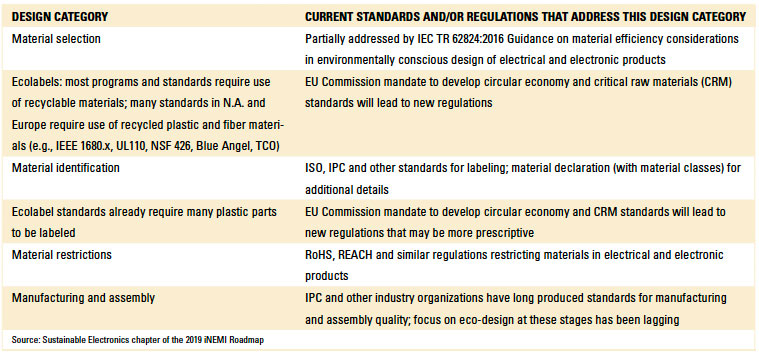Market Forces and Regulations Converge on Eco-Design
Cost savings, boosted by European Commission initiatives, drive product designers to implement eco-design.
Ed.: This is the first of an occasional series by the authors of the 2019 iNEMI Roadmap. This information is excerpted from the roadmap, available from iNEMI (inemi.org/2019-roadmap-overview).
A common misconception is that eco-design adds costs to products. In fact, nearly every eco-design principle reduces product costs. The growing demand for more environmentally sustainable products, coupled with increasing regulatory restrictions, is motivating electronics manufacturers to leverage eco-design principles and the circular economy model to simultaneously build business value, decrease product costs and mitigate harm to the environment and society. Progress in eco-design since the 2017 iNEMI Roadmap has been driven largely by upcoming requirements from regulatory bodies and competition-driven initiatives; the latter stems from stakeholders’ increasing awareness of the toxicity, CO2 emissions, social inequities, and costs attached to many materials in the extraction, manufacturing, transportation, use and post-use phases.
The European Commission (EC) remains the most active driver of regulatory eco-design requirements, especially in removing hazardous substances from products and in creating mandates for new standards related to the circular economy. For instance, the electronics industry is actively removing four phthalate substances in advance of RoHS restrictions that take effect starting in 2019. Also, in early 2018, the EC launched its next round of substance reviews for possible restriction in electronic products.
Moreover, 10 European standards to enable future initiatives and regulations on the circular economy are in the final stages of development. These standards address definitions, requirements and methods for product durability; ability to remanufacture as well as to repair, reuse, and upgrade; recyclability and recoverability; and a proportion of reused components and recycled material. (According to the Ellen MacArthur Foundation, the circular economy is a way to design, make and use things within planetary boundaries, by designing out waste and pollution, keeping products and materials in use, and regenerating natural systems.)
Finally, the desire to leverage recycled materials for new product manufacturing is calling for the elimination of all hazardous substances from products.
Concurrently, a burgeoning number of product companies are implementing voluntary eco-design initiatives – sometimes to earn eco-labels including EPEAT, and sometimes to achieve business value through product-and-process innovations.
The competitive pressure comes from increasing education of, and demands for, responsibility by a broad range of stakeholders, including leading manufacturers, purchasers, governments, NGOs and the experiences from reuse and recycling service providers. Some of the most recent initiatives include increases in these areas: • Proactive identification/elimination of hazardous substances and the use of alternative assessment methods to evaluate substitute materials and chemicals.
- Requirements for recycled content in plastic materials.
- Closed-loop recycling of plastic materials for use in similar products.
- Push of eco-design requirements into the supply chain, which can be supported by standards.
- Corporate social responsibility and responsible sourcing of materials and services.
- Energy management, including product energy efficiency and use of renewable energy by manufacturers and suppliers.
- Flexibility to reuse and repair products.
To mitigate economic, environmental, and social issues present today and expected to intensify during the next 10 years, the global electronics industry must incorporate eco-design principles throughout product and package development, supply chains, manufacturing, logistics, use-phase, and post-use value retention.
Looking forward to the next 10 years, the roadmap anticipates changes to, and impacts from, regulations and standards relative to eco-design, summarized in TABLE 1.
Table 1. Anticipated Changes to, and Impacts from, Future Regulations

Source: Sustainable Electronics chapter of the 2019 iNEMI Roadmap
This excerpt from the 2019 iNEMI Roadmap is based on the Eco-Design section of the Sustainable Electronics chapter, chaired by director of partnerships for Presidio Graduate School.
Register now for PCB West, the leading conference and exhibition for printed circuit board design! Coming Sept. 9-12 to the Santa Clara Convention Center. pcbwest.com







